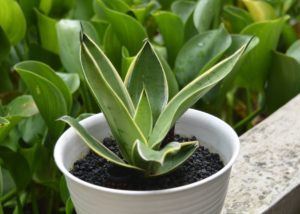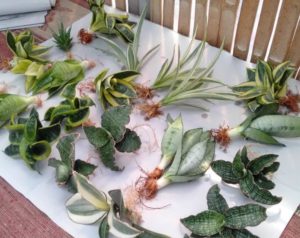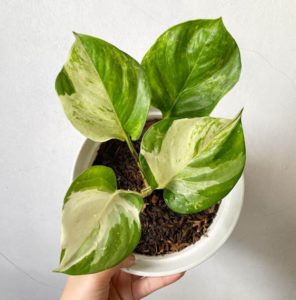The snake plant, also known as Sansevieria trifasciata, is an exceptionally tough, easy-to-grow, low-maintenance plant that tolerates low light and neglect.
While this plant is commonly known as Sansevieria trifasciata, it actually has been reclassified into the new scientific name, Dracaena trifasciata.
But you’ll see plant enthusiasts calling it different names that are slightly clumsy. For instance, “mother-in-law’s tongue” because of its sword-shaped leaves.
It is also called the “viper’s bowstring hemp” because the fibers obtained from the plant were once used in making bowstrings.
Today, it is a common houseplant used in offices and homes alike due to its ability to thrive indoors with little attention or care needed.
The snake plant is one of the most popular and most accessible to grow houseplants. It’s one of the top plants for purifying the air.
Even NASA’s research has shown that the snake plant purifies the air in your home and removes the toxins.
Let’s get started to know more about snake plants!
In this post
Types of Snake Plant
If you’re looking for a snake plant, you have your choice of over 70 varieties. Not all snake plants are created equal—some grow huge, some stay small, and some have variegation that is more or less pronounced.
The good news is that all of them are easy to take care of because they are succulents and do not need to be watered that often. Because they will grow without much attention, it is essential to know what you want in advance to avoid a plant that you can’t handle.
Choosing the right Snake Plant for your home can be tricky with so many varieties available on the market today. There are many reasons to love the snake plant, with its beautiful leaf shapes and colors.
If you have your heart set on one of these unique-looking plants, here are a few types to consider:
1. Sansevieria trifasciata ‘Bantel’s Sensation’
Bantel’s sensation grows to 3 feet tall and has narrow leaves with white vertical stripes. This one is great if you want something that looks more like an actual snake—it has a pointy end and is tall and thin! It also looks like it glows in the dark, making it the perfect accent for any room.
2. Sansevieria trifasciata ‘Rhino Grass’
Sansevieria pearsonii or ‘Rhino Grass’ grows to only about 12 inches tall, but it’s got a unique-shaped leaves that make it look like something from another planet!
3. Sansevieria trifasciata ‘Cylinderica’
The Dracaena ‘Cylinderica’ has round dark green, striped leaves and can grow to 2 to 3 feet. If you’re looking for something more compact, Dracaena ‘Boncellensis’ is a smaller plant with smooth, gray-green cylindrical leaves that grow tiny white blooms.
4. Sansevieria trifasciata ‘Golden Hahnii’
Sansevieria Golden Hahnii is another popular variety. It has short leaves with yellow borders and is often called a “bird’s nest snake plant” because it looks like a bird’s nest when it’s full of sharp, dense leaves. It’s also a mini snake plant that grows no more than 20 cm!
How to Grow a Snake Plant
The easiest way to propagate snake plants is by dividing offsets produced by the roots. These fleshy rhizomes can be easily removed with a sharp knife and potted up.
One of the most important things to remember when growing a snake plant is that it does not like to be overwatered. This can quickly rot the roots. The soil should also be free draining and dry out between each watering.
Snake Plant Care
Snake plants are an excellent choice for anyone looking to get started in plant care, as they’re resilient, low-maintenance, and adapt to various conditions.
These plants will thrive as long as you keep them away from cold temperatures and provide healthy soil and indirect light.
They also need very little water—only if the soil feels dry. They can go up to two months in the winter months without watering!
To help you get started with your new plant, here’s some information on what makes a good home for your snake plant:
1. Light Requirements
Snake plants prefer indirect but steady light, though they adapt well to full sun conditions.
2. Soil Requirements
In terms of soil requirements, the loose and well-drained potting mix will keep them happy—all-purpose cactus potting soil is a good choice.
3. Water Requirements
These plants can go two months between waterings in the winter months, so go ahead and let the soil dry out before watering again.
If you’re not sure whether or not the soil’s ready for a drink, stick your finger about an inch deep into the soil. If it feels dry, water it until water comes out of the drainage holes on the bottom of the pot.
4. Fertilizer
The snake plant only requires a small amount of fertilizer. While it is essential to fertilize the soil, the snake plant can flourish with minimal nutrients.
Common Snake Plant Problems
Snake plant problems don’t have to be scary. They might seem like they’re taking over your life, but we’re here to help you fix them so you can get back to enjoying your beautiful snake plant! Here are the most common problems and how to fix them:
1. Root Rot
If the roots are rotting, it’s likely because the plant hasn’t been watered in a long time. The best thing is to take the plant out of its pot and inspect the roots. If they’re brown, mushy, or smell bad, it’s best just to cut those off and repot the plant in new soil (after it’s had a chance to dry out).
2. Turning Yellow
Your snake plant is likely suffering from too much sun or water. Make sure you’re only watering it when the top of the soil is dry, and if it’s still turning yellow after that, try moving it somewhere with less sunlight.
3. Underwatered
This can happen if you forget about your snake plant for a bit. To refresh it, give it a good drink of water and place it by a sunny window—this will help revive it to get back to enjoying your beautiful green friend!
4. Brown Spot
This could mean there’s something wrong with your soil (like too much fertilizer), so make sure there isn’t any build-up by rinsing off excess dirt before repotting.
5. Root Bound
If you notice that your snake plant is starting to look like a poodle, it might be root bound. This happens when your plant’s pot is too small for its roots. You can fix it by repotting it into a larger container.
6. Wrinkled Leaves
Snake plants get thirsty! If you notice their leaves looking creased and wrinkled, water them right away—they’re probably dry.
7. Curling Leaves
Your snake plant may also experience curling or drooping leaves if they’re not getting enough water or sunlight. Be sure to give them both!
8. Falling Over
Snake plants can grow pretty tall, so if yours starts falling over, you might want to stake it up or put it in a more prominent planter with more weight to keep it upright.
9. Bugs
Unfortunately, pests love the snake plant just as much as we do. If you see minor bugs on your plant (or weird spots on the leaves), spray the whole thing with insecticide and wipe the leaves down with a damp cloth to remove any eggs.
FAQ about Snake Plant
Can I Put a Snake Plant Outside?
The snake plant (Sansevieria trifasciata) has a reputation for surviving inhospitable conditions.
They can withstand drought and neglect, so it’s understandable why people want to take them out of the house and put them in the garden.
However, the snake plant is not going to thrive outside. While they may be able to survive a few months of cool weather and shady conditions, they will not last long outdoors.
How Fast Does Snake Plant Grow?
A snake plant can grow up to 8 feet high when grown indoors and 12 feet when planted outdoors. Also known as Sansevieria, this plant grows very slowly, so it won’t need repotting too often.
Keeping the snake plant in a bright spot that remains warm but away from draughts and direct heat sources such as radiators or hot air vents is essential.
How Can I Tell If It’s Dying?
If your snake plant is dying, you may see wet round spots that look a little like large blisters.
After the spots are visible, they can grow until they become sunken, and the leaf material below the spots becomes sunken and mushy.
The good news is that there’s usually an easy way to save your snake plant—by simply letting it dry out for a few days.
However, if it’s too late and your plant has died, don’t fret! You can just buy more soil and start again with a new snake plant.
Final Words
There you have it – your complete guide to everything about snake plants!
Hopefully, we have covered every aspect you need to know about the snake plant.
The good news is that all of them are easy to take care of because they are succulents and do not need to be watered that often.
Because they will grow without much attention, it is essential to know what you want in advance to avoid a plant that you can’t handle.
You’ve found a good home for your snake plant if you’ve got a spare corner of your apartment that gets a little bit of light but no direct sun.
Now, you are good to go with planting your snake plant!



